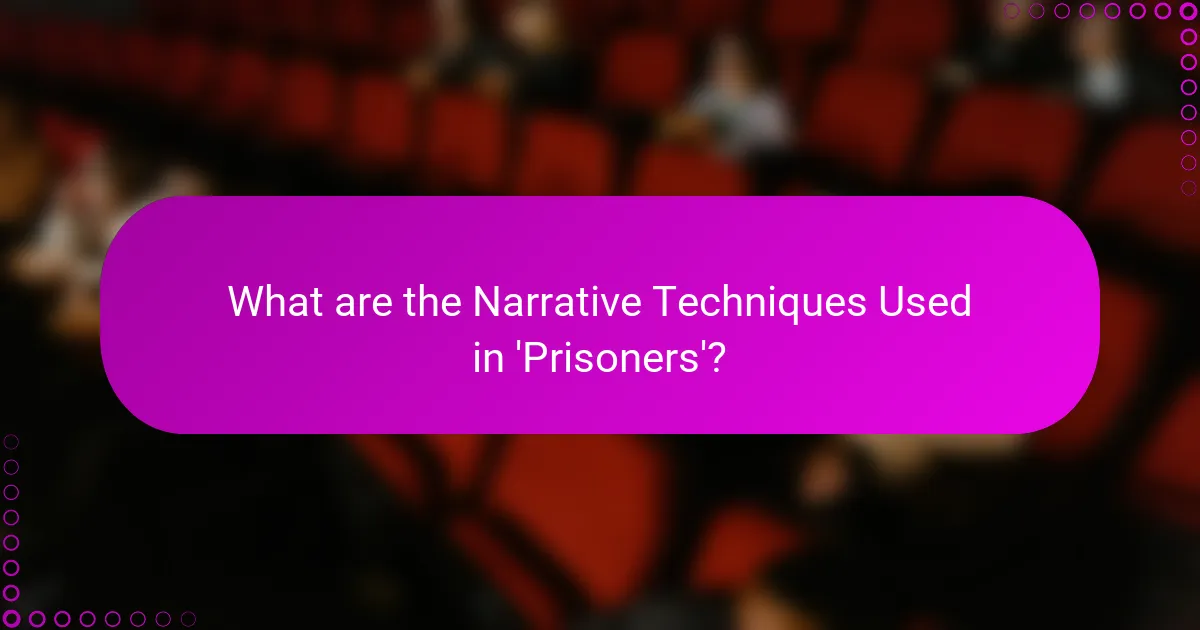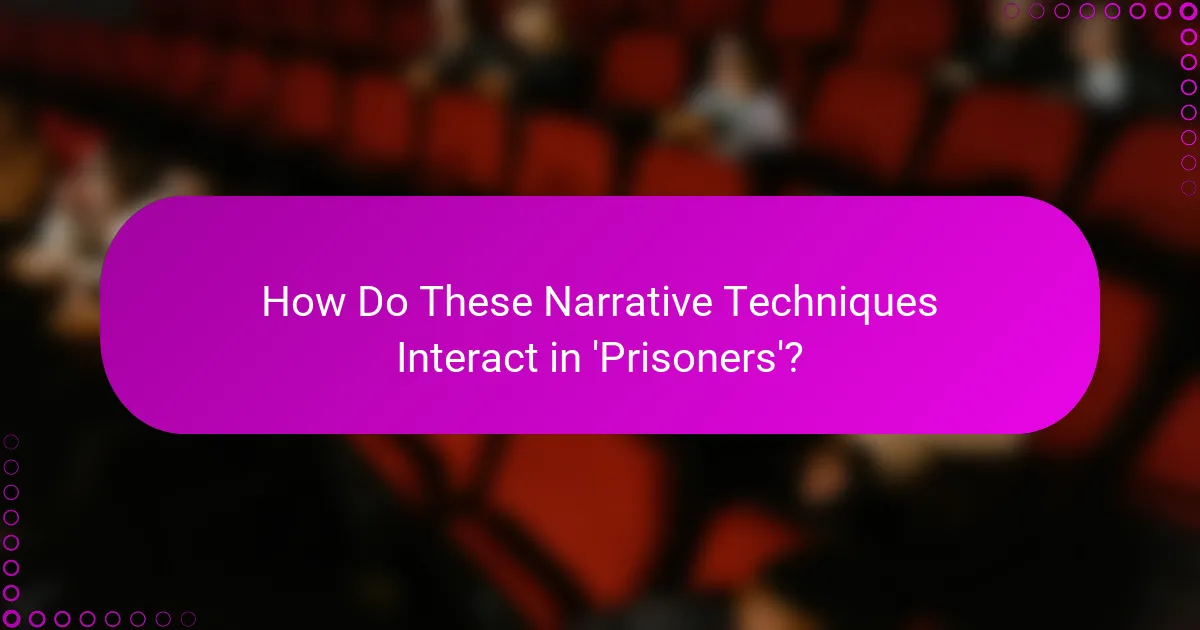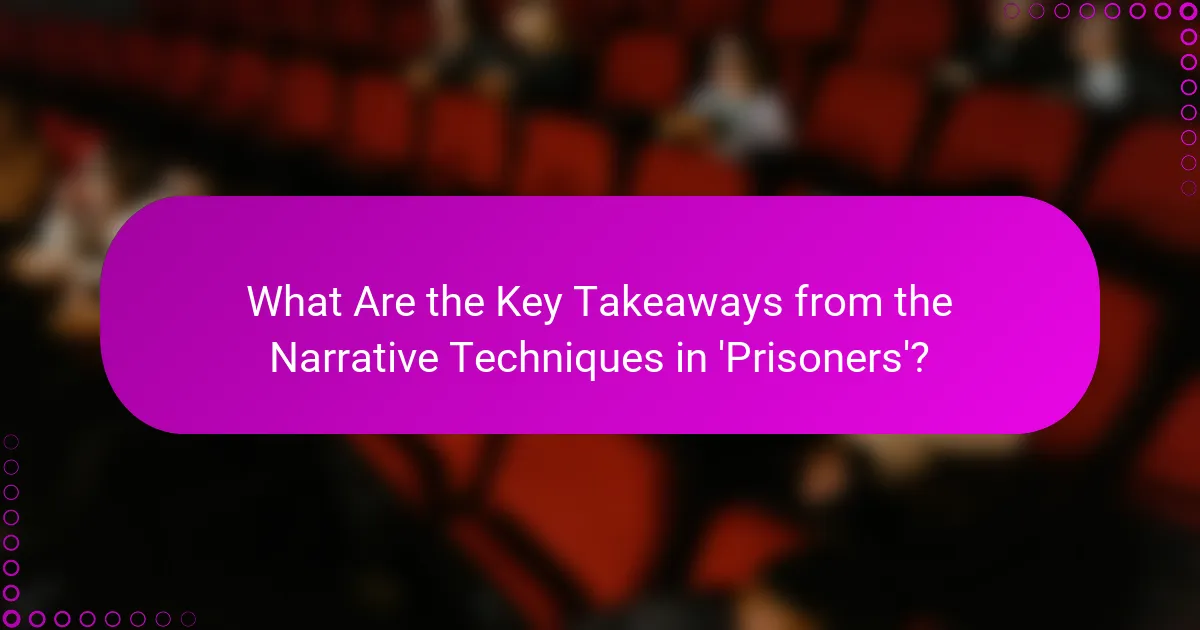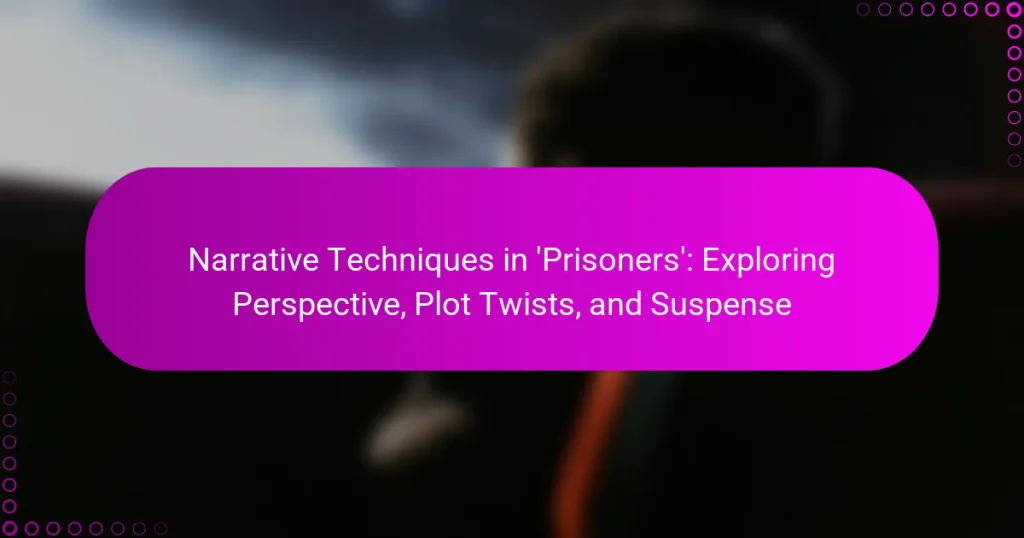The article examines the narrative techniques used in the film “Prisoners,” focusing on how these methods enhance storytelling. Key elements discussed include non-linear storytelling, multiple perspectives, and the use of plot twists, all of which contribute to building suspense and emotional engagement. The interplay of visual and auditory elements, such as lighting and sound design, is also highlighted, as is the symbolism represented by the maze. These techniques work together to create a gripping narrative experience that keeps the audience invested in the unfolding mystery. The article provides an in-depth analysis of how these strategies shape viewer perceptions and reactions throughout the film.

What are the Narrative Techniques Used in ‘Prisoners’?
‘Prisoners’ employs various narrative techniques to enhance storytelling. These include non-linear storytelling, which creates suspense by revealing information gradually. The film uses multiple perspectives, highlighting different characters’ emotional states and motivations. Tension is built through visual and auditory elements, such as lighting and sound design. The use of symbolism, particularly in the representation of the maze, adds depth to the narrative. Additionally, plot twists keep the audience engaged and guessing throughout the film. These techniques collectively contribute to a gripping and immersive viewing experience.
How does Perspective Shape the Storytelling in ‘Prisoners’?
Perspective significantly shapes the storytelling in ‘Prisoners’ by influencing the audience’s understanding of characters and events. The film employs a dual perspective, alternating between the viewpoints of the parents and the detective. This approach creates tension and empathy, allowing viewers to connect with the emotional turmoil of the families. The fragmented narrative structure adds complexity, revealing information selectively. As a result, the audience experiences confusion and suspense, mirroring the characters’ desperation. The use of limited omniscient perspective also deepens the mystery, as viewers are not privy to all details. This technique enhances the film’s themes of morality and justice, prompting reflection on the characters’ choices. Overall, perspective is a crucial narrative device that shapes the emotional landscape of ‘Prisoners’.
What types of perspectives are presented in ‘Prisoners’?
‘Prisoners’ presents multiple perspectives, primarily focusing on the viewpoints of the main characters. The film utilizes a third-person omniscient perspective to provide insight into the thoughts and emotions of various individuals. This technique allows viewers to understand the motivations behind the actions of both the parents and law enforcement. Additionally, the narrative shifts between the perspectives of the kidnapped girls and their families. This creates a sense of urgency and tension throughout the plot. The use of these varied perspectives enhances the emotional depth and complexity of the story. By exploring different viewpoints, the film emphasizes themes of desperation, morality, and the lengths one will go to for loved ones.
How does the choice of perspective influence the audience’s understanding?
The choice of perspective significantly influences the audience’s understanding by shaping their interpretation of events. Different perspectives can create varying levels of empathy or bias towards characters. For instance, a first-person perspective allows deeper insight into a character’s thoughts and emotions. This can lead to a stronger emotional connection with that character. Conversely, a third-person perspective may provide a more objective view, allowing the audience to analyze multiple characters’ motivations. Research shows that perspective affects narrative engagement, as highlighted in studies by Zunshine (2006) on reader comprehension. Thus, the choice of perspective is crucial in guiding audience perception and emotional response.
What Role Do Plot Twists Play in ‘Prisoners’?
Plot twists in ‘Prisoners’ serve to enhance tension and challenge viewer expectations. They create moments of shock that propel the narrative forward. For instance, the revelation of unexpected character motivations alters the audience’s understanding of the plot. This technique keeps viewers engaged and invested in the outcome. The twists also reflect the themes of moral ambiguity and desperation. By subverting typical storytelling conventions, the film deepens its exploration of human nature. Overall, plot twists are crucial for maintaining suspense and driving emotional impact in ‘Prisoners’.
How are plot twists crafted within the narrative?
Plot twists are crafted within a narrative by subverting audience expectations. This technique involves planting clues that mislead the audience while building a coherent storyline. Effective plot twists often rely on character development and motivations that are revealed at critical moments. The timing of the twist is essential; it should occur when the audience feels comfortable with their assumptions.
In ‘Prisoners’, the narrative employs misdirection through character interactions and layered storytelling. For instance, the seemingly innocent characters are given darker complexities as the plot unfolds. This creates a sense of unpredictability, enhancing the impact of the twist.
Moreover, foreshadowing plays a crucial role in crafting plot twists. Subtle hints are woven throughout the narrative, allowing for a satisfying revelation when the twist occurs. This method engages the audience and encourages them to re-evaluate earlier scenes.
Overall, plot twists are an intricate blend of misdirection, character depth, and strategic timing, all contributing to a compelling narrative experience.
What impact do these twists have on the viewer’s experience?
Twists in a narrative significantly enhance the viewer’s experience. They create unexpected moments that provoke strong emotional reactions. This unpredictability keeps viewers engaged and invested in the story. Twists also encourage viewers to reassess their understanding of characters and plot. They can lead to heightened suspense and tension throughout the viewing experience. Research shows that audiences often enjoy the thrill of surprise in storytelling. This enjoyment can lead to deeper discussions and analyses of the film. Overall, twists contribute to a more dynamic and memorable cinematic experience.
How is Suspense Built Throughout ‘Prisoners’?
Suspense in ‘Prisoners’ is built through a combination of tension-filled scenarios and character dilemmas. The narrative employs a non-linear timeline that reveals critical information gradually. This technique keeps the audience guessing about the fate of the characters. The use of dark, atmospheric cinematography enhances the feeling of unease. Characters face moral quandaries that raise stakes and provoke anxiety. The pacing of the plot is deliberately slow, allowing tension to mount over time. Cliffhangers and unexpected twists further contribute to the suspenseful atmosphere. For example, the revelation of key clues at pivotal moments keeps viewers on edge.
What techniques are employed to create suspense in the film?
Filmmakers employ various techniques to create suspense in ‘Prisoners’. Tension is built through pacing, often slowing down scenes to heighten anxiety. The use of music and sound design adds an auditory layer of unease. Visual elements, such as low lighting and tight framing, create a claustrophobic atmosphere. Plot twists and cliffhangers keep viewers guessing about character fates. Character development fosters emotional investment, making stakes feel personal. Foreshadowing hints at future events, enhancing anticipation. The interplay of perspectives creates uncertainty regarding character motivations. Collectively, these techniques effectively engage the audience and maintain suspense throughout the film.
How does suspense affect the pacing of the narrative?
Suspense accelerates the pacing of the narrative by creating tension and anticipation. It compels readers to engage more deeply with the plot. As suspense builds, the narrative often shifts to shorter sentences and rapid scene changes. This technique enhances urgency and keeps the audience on edge. In ‘Prisoners’, moments of suspense lead to quick revelations and unexpected twists. These elements contribute to a faster narrative rhythm. Research shows that heightened suspense can increase reader investment in the story. This connection between suspense and pacing is crucial for maintaining audience interest and emotional involvement.

How Do These Narrative Techniques Interact in ‘Prisoners’?
Narrative techniques in ‘Prisoners’ interact by creating tension and enhancing emotional engagement. The use of multiple perspectives allows viewers to understand characters’ motivations deeply. Plot twists serve to challenge assumptions and maintain suspense throughout the film. The interplay of these techniques keeps the audience invested in the unfolding mystery. For example, the shifting viewpoints reveal hidden truths, leading to shocking revelations. Suspense is built through pacing and strategic reveals, making the audience question what will happen next. This combination of techniques culminates in a gripping narrative experience.
What is the relationship between perspective and suspense?
Perspective shapes how suspense is experienced in narrative storytelling. It determines what information is available to the audience and characters. A limited perspective can create uncertainty, enhancing suspense. For example, when viewers know less than the characters, tension builds as they anticipate revelations. Conversely, an omniscient perspective can reduce suspense by revealing outcomes. Studies in narrative theory show that perspective directly influences emotional engagement. The relationship between perspective and suspense is crucial in crafting effective storytelling.
How do plot twists enhance the suspense in the narrative?
Plot twists enhance suspense by introducing unexpected developments that challenge audience assumptions. These twists create a sense of unpredictability, keeping viewers engaged. When a plot twist occurs, it often recontextualizes earlier events, deepening intrigue. This shift in perspective can raise emotional stakes for characters, making their outcomes more compelling. Research shows that narratives with plot twists maintain higher viewer interest and emotional response. For example, studies indicate that surprise elements can increase dopamine levels, enhancing pleasure and engagement in storytelling. Thus, plot twists are effective tools for maintaining suspense in narratives.

What Are the Key Takeaways from the Narrative Techniques in ‘Prisoners’?
The key takeaways from the narrative techniques in ‘Prisoners’ include the use of multiple perspectives, intricate plot twists, and sustained suspense. The film employs a non-linear storytelling approach, allowing viewers to experience events from different characters’ viewpoints. This technique deepens emotional engagement and enhances the mystery. The narrative features unexpected plot twists that challenge assumptions and keep the audience guessing. The pacing and structure of the story maintain a high level of suspense throughout. These elements combine to create a gripping and thought-provoking cinematic experience.
What lessons can filmmakers learn from ‘Prisoners’ in terms of narrative structure?
Filmmakers can learn the importance of tension and pacing from ‘Prisoners’. The film uses a slow build-up to create suspense. This technique keeps audiences engaged and invested in the characters. It also employs multiple perspectives to deepen the narrative complexity. By shifting viewpoints, the film reveals critical information gradually. This method enhances emotional impact and viewer empathy. Additionally, the use of plot twists keeps the audience guessing. Such surprises can elevate the narrative and maintain interest throughout. These elements combined demonstrate effective narrative structure in thriller filmmaking.
How can these techniques be applied to other genres?
Narrative techniques such as perspective shifts, plot twists, and suspense can be effectively applied to other genres. In mystery novels, perspective shifts can deepen the reader’s engagement by revealing multiple viewpoints. Plot twists can enhance the unpredictability of the story, keeping readers on edge. Suspense is crucial in thrillers, creating tension that propels the narrative forward.
In fantasy, perspective shifts can introduce complex world-building through different character lenses. In romance, plot twists can challenge expectations, adding depth to character relationships. Suspense in horror can amplify fear, making the narrative more gripping.
These techniques have been successfully utilized across genres, demonstrating their versatility and effectiveness in storytelling.
What are common pitfalls to avoid when using these techniques?
Common pitfalls to avoid when using narrative techniques in “Prisoners” include losing clarity in perspective. When shifting viewpoints, ensure the transitions are smooth to avoid confusing the audience. Another pitfall is overusing plot twists, which can lead to diminishing returns. If twists are too frequent or forced, they can feel contrived rather than surprising. Additionally, neglecting character development can undermine suspense. Audiences need to connect with characters to feel invested in their fates. Lastly, failing to maintain a consistent tone can disrupt the narrative flow. Each of these pitfalls can detract from the effectiveness of the storytelling.
How can viewers analyze narrative techniques in films like ‘Prisoners’?
Viewers can analyze narrative techniques in films like ‘Prisoners’ by examining character perspectives, plot structure, and suspense elements. The film employs multiple viewpoints to create tension and ambiguity. It uses nonlinear storytelling to enhance emotional impact. Viewers should note how plot twists are strategically placed to surprise the audience. The pacing of revelations contributes significantly to the film’s suspense. Analyzing dialogue can reveal deeper motivations and themes. Additionally, visual storytelling techniques, such as lighting and framing, complement the narrative. These aspects collectively shape the viewer’s understanding of the story.
The main entity of the article is the narrative techniques used in the film ‘Prisoners’. The article provides an overview of how non-linear storytelling, multiple perspectives, and plot twists enhance the film’s suspense and emotional engagement. It explores the impact of perspective on audience understanding, the crafting of plot twists, and the techniques employed to build suspense throughout the narrative. Key takeaways highlight the importance of pacing, character development, and the strategic use of narrative elements to create a compelling cinematic experience. Additionally, the article discusses lessons for filmmakers and how these techniques can be applied across various genres.


